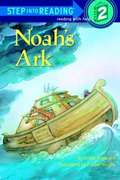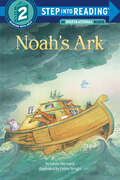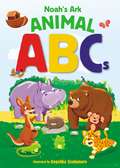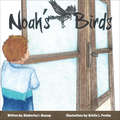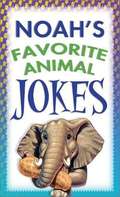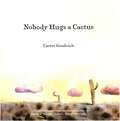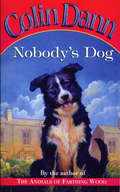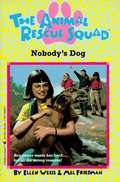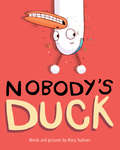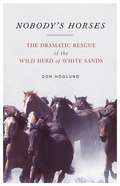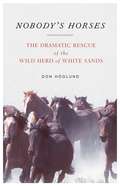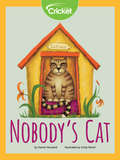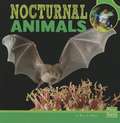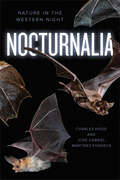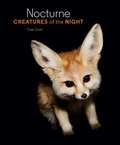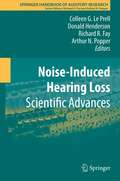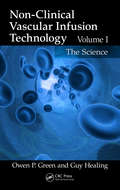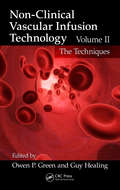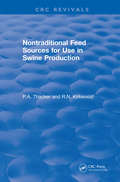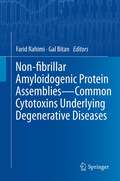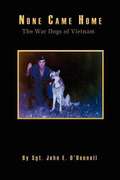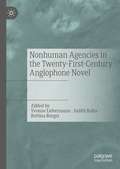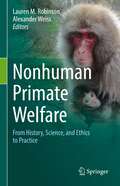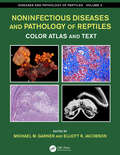- Table View
- List View
Noah's Ark (Step 1 Book)
by Linda HaywardThe story of the most famous menagerie ever is presented in a retelling created especially for the very youngest beginning reader. A simple retelling of the Old Testament story of Noah, who followed God's orders to build a great ark in preparation for the coming flood.
Noah's Ark (Step into Reading)
by Linda HaywardThis beloved bible story is now available for emerging readers!Noah's Ark, one of the bible's most beloved stories, is now available for beginning readers in this Step into Reading (Step 1) edition of the exciting tale. Join Noah, his family, and two of every animal, for a story full of adventure, hope, and love.Step 1 Readers feature big type and easy words for children who know the alphabet and are eager to begin reading. Rhyme and rhythmic text is paired with picture clues to help children decode the story.
Noah's Ark Animal ABCs
by ZondervanPlayful and educational, Noah&’s Ark Animal ABCs brings alphabet learning together with a family favorite: the animals of Noah&’s ark!With engaging and eye-popping illustrations of animals for each letter of the alphabet, young readers will love guessing which creature comes next. From Ant to Zebra, this delightful book introduces children to the alphabet and some of the interesting creatures aboard Noah&’s ark. Perfect for parents and children to enjoy together!Noah&’s Ark Animal ABCs:Features easy-to-learn alphabet words and interesting animalsOffers bright, eye-catching illustrations to enhance word memory
Noah's Birds
by Kimberley MassopShoo is a blackbird with a bad wing.When teased by the other blackbirds, he befriends lonely little Noah who shares his after school cookie with Shoo and they quickly become friends. When Shoo learns Noah has to move to Allentown, he decides to fly there, because he doesn&’t want Noah to be alone. However, because of his bad wing, Shoo cannot fly all the way to Allentown.He meets Sergeant Brave in Ocean City, a highly decorated rescue pigeon recently retired from the Coast Guard. Although blackbirds and pigeons are not supposed to speak to each other or get along, Sergeant Brave is inspired by Shoo's story of friendship with Noah and decides to take up the journey to find Noah and be his new friend in Allentown.Come fly with Sergeant Brave as the pigeons continue the journey to find Noah, be his new friend and share the after school cookie.
Noah's Favorite Animal Jokes
by Jennifer HahnWhy did the chicken cross the road? To pick up a copy of Noah's Favorite Animal Jokes! This brand-new collection--categorized by wacky animals and hilarious situations--is sure to make anyone laugh... even you old sourpusses!<p> From talking dogs to cranky gorillas to chickens that cross the road, Noah's Favorite Animal Jokes is packed with five hundred classic, crazy, and/or corny stories, riddles, and one-liners appropriate for any age group.
Nobody Hugs a Cactus
by Carter GoodrichHank, a cactus who is as prickly on the inside as he is on the outside, decides he wants a hug.
Nobody's Dog
by Colin DannHow does it feel to be abandoned? To wake up one morning cold and miserable in a strange, unfamiliar place where no one even knows your name? This is what happens to a cross-breed collie who is separated from his brother when his family finds two dogs too difficult to cope with. Will he survive? And will he ever find a home where he is really wanted?
Nobody's Dog (Animal Rescue Squad #4)
by Ellen Weiss Mel FriedmanThe first time I saw Belle was the day of the Animal Rescue Squad's Christmas shopping expedition. Eliza Spain, Lisa Ho, Abby Good¬man, and I, Molly Penrose--we're the Animal Rescue Squad--were on our way to Mr. Slattery's store. Slattery's is jam-packed with nice little things like candles and pottery and potpourri. I needed to get presents for my mother and my sister, and I wanted to scout out things for Eliza, Lisa, and Abby as well. Then we saw a dog.
Nobody's Duck
by Mary SullivanWhen a duck mysteriously arrives on an alligator’s lawn, they set off to discover just who the duck belongs to. From the library to skydiving, from exasperation to laughter, the two make an unexpected discovery about friendship. Readers will delight in this odd couple’s wacky adventures that feature the signature wit and ingenuity of Geisel Honor winner Mary Sullivan. Like its predecessors Ball, Treat, and Frankie, Nobody’s Duck has humor and heart in spades (and quacks).
Nobody's Horses: The Dramatic Rescue of the Wild Herd of White Sands
by Don HöglundDescended from the greatest horses of the American West, the wild horses living on the White Sands Missile Range in New Mexico -- one of the most dangerous places on Earth -- were a national treasure and a living legend. Big, strong, beautiful, and fierce, their ancestors were the mounts of the famous lawmen, hardy cowboys, and notorious outlaws who had once ruled the Wild West. Over the years, these far-flung herds of the Land of Enchantment had inspired many myths, and were said to be guarded by an implacable band of enormous, ghostly stallions that kept them from harm. But in 1994, after decades of suffering through droughts, food shortages, and all the dangers that go with living on a military-weapons testing site, scores of horses suddenly died. And almost two thousand were in such dire straits that they were unlikely to survive. In a race to prevent more tragic deaths, large-animal veterinarian Don Höglund was called in to organize and lead a team of dedicated cowboys, soldiers, and other professionals in removing the surviving horses and their babies to safety. Then would come the challenge of rehabilitating them, and eventually placing them in loving homes with people who could meet the needs of the highly spirited wild animals. For the first time in book form,Nobody's Horses tells the dramatic story of these noble horses' celebrated history, their defiant survival, and their incredible rescue. During the complex rescue, stampedes, escapes, and injuries ensued as well as struggles with animal rights activists and army officials. Everyone was in constant danger from unspent munitions on the ground and missile testing in the air. Cowboys, Native Americans, and ranchers -- all of whom cared deeply about the fate of the horses -- clashed in a battle of wills. And, of course, there were the horses themselves -- wild, extraordinarily powerful animals, not easily managed or moved, who would become known to their rescuers as fascinating, individual characters -- the wily old mares who evaded capture and led their bands to water and food, the beautiful colts and their amazing resilience and ability to bond with humans and each other, and the magnificent, powerful stallions who protected their harems and young against humans and predators. Luckily Höglund's team was also extraordinary, and their mission a celebrated success for all the people involved, the horses that were rescued, and the grateful families who adopted these living pieces of an American legacy. Filled with history and heroism, adventure and rivalry, and, ultimately, the heartwarming alliances between horses and people, which made the whole endeavor worthwhile, Nobody's Horses will stir the emotions and imaginations of horse lovers, humanitarians, and anyone who loves an uplifting tale of second chances. It's a story of how Nobody's Horses became Everybody's Horses.
Nobody's Horses: The Dramatic Rescue of the Wild Herd of White Sands
by Don HöglundDescended from the greatest horses of the American West, the wild horses living on the White Sands Missile Range in New Mexico -- one of the most dangerous places on Earth -- were a national treasure and a living legend. Big, strong, beautiful, and fierce, their ancestors were the mounts of the famous lawmen, hardy cowboys, and notorious outlaws who had once ruled the Wild West. Over the years, these far-flung herds of the Land of Enchantment had inspired many myths, and were said to be guarded by an implacable band of enormous, ghostly stallions that kept them from harm. But in 1994, after decades of suffering through droughts, food shortages, and all the dangers that go with living on a military-weapons testing site, scores of horses suddenly died. And almost two thousand were in such dire straits that they were unlikely to survive. In a race to prevent more tragic deaths, large-animal veterinarian Don Höglund was called in to organize and lead a team of dedicated cowboys, soldiers, and other professionals in removing the surviving horses and their babies to safety. Then would come the challenge of rehabilitating them, and eventually placing them in loving homes with people who could meet the needs of the highly spirited wild animals. For the first time in book form, Nobody's Horses tells the dramatic story of these noble horses' celebrated history, their defiant survival, and their incredible rescue. During the complex rescue, stampedes, escapes, and injuries ensued as well as struggles with animal rights activists and army officials. Everyone was in constant danger from unspent munitions on the ground and missile testing in the air. Cowboys, Native Americans, and ranchers -- all of whom cared deeply about the fate of the horses -- clashed in a battle of wills. And, of course, there were the horses themselves -- wild, extraordinarily powerful animals, not easily managed or moved, who would become known to their rescuers as fascinating, individual characters -- the wily old mares who evaded capture and led their bands to water and food, the beautiful colts and their amazing resilience and ability to bond with humans and each other, and the magnificent, powerful stallions who protected their harems and young against humans and predators. Luckily Höglund's team was also extraordinary, and their mission a celebrated success for all the people involved, the horses that were rescued, and the grateful families who adopted these living pieces of an American legacy. Filled with history and heroism, adventure and rivalry, and, ultimately, the heartwarming alliances between horses and people, which made the whole endeavor worthwhile, Nobody's Horses will stir the emotions and imaginations of horse lovers, humanitarians, and anyone who loves an uplifting tale of second chances. It's a story of how Nobody's Horses became Everybody's Horses.
Nobody’s Cat
by Fannie PeczenikGattone enjoys the attention he gets from people along with the food and bedding, but he enjoys his freedom even more. Gattone is nobody’s cat and that’s the way he wants to be—or is it?
Nocturnal Animals
by Bernd Heinrich Kelli L. HicksHow do over-sized eyes help tarsiers see at night? How do bats find food in the dark? These nocturnal animals have some fascinating ways to survive in the dark. Discover the amazing things nocturnal animals do when the sun goes down.
Nocturnalia: Nature in the Western Night
by Charles Hood José Gabriel Martínez-FonsecaDon’t be afraid of the dark: grab a flashlight and rediscover your sense of adventure!Darkness is something humans strive to keep at bay, but under the glow of twilight a nocturnal universe stirs to life. Nightshade blossoms bloom, javelinas parade down city streets, fox eyes gleam under the cover of the forest, and tiny sparrows fly incredible distances, guided by the stars. Naturalist Charles Hood and bat biologist José Gabriel Martínez-Fonseca unravel these enigmas in Nocturnalia, inviting readers on an environmental romp through the wonders of the Wild West. Their sundown dispatches, featuring over 100 photographs from California and the American Southwest, take us from the astronomical canopy overhead, to the flora that unfurl under moonshine, to the creatures that go bump in the night. With practical tips for the budding nighttime naturalist, the authors invite citizen scientists of all stripes to expand our knowledge of this final frontier and our understanding of life on Earth. Exploring the evolutionary adaptations of owls, bats, and other nightlife animals; the natural history of nighttime plants; and the celestial patterns that regulate this after-dark kingdom, Hood and Martínez-Fonseca lift their lanterns to illuminate the exquisite and intricate inner workings of nature after nightfall.
Nocturne
by Traer ScottWhether fierce, cuddly, startling, mysterious, or some indefinable combination of all of the above, nocturnal animals never fail to fascinate. In Nocturne: Creatures of the Night, celebrated animal photographer Traer Scott takes the viewer on a journey through nighttime in the animal kingdom, revealing some of nature's most elusive creatures. Bats, big cats, flying squirrels, tarantula, owls, kangaroo mice, giant moths, sloth, several species of snakes, and a Madagascar hissing cockroach are only a few of the animals illuminated in these lushly detailed portraits. Seventy-five full-color photographs of forty different species are accompanied by informed but accessible descriptions of each animal's habits and habitats, and an introduction provides personal insight into how Scott captures her astonishing images. Nocturne is a compelling view of the rarely seen darkness dwellers who populate the night.
Noise-Induced Hearing Loss
by Arthur N. Popper Richard R. Fay Donald Henderson Colleen G. Le PrellExposure to loud noise continues to be the largest cause of hearing loss in the adult population. The problem of NIHL impacts a number of disciplines. US standards for permissible noise exposure were originally published in 1968 and remain largely unchanged today. Indeed, permissible noise exposure for US personnel is significantly greater than that allowed in numerous other countries, including for example, Canada, China, Brazil, Mexico, and the European Union. However, there have been a number of discoveries and advances that have increased our understanding of the mechanisms of NIHL. These advances have the potential to impact how NIHL can be prevented and how our noise standards can be made more appropriate.
Non-Clinical Vascular Infusion Technology, Volume I: The Science
by Owen P. Green Guy HealingIntravenous infusion is a necessary mode of delivery for many pharmaceuticals currently on the market or undergoing clinical trials. The technique of prolonged intravenous delivery in conscious, free-moving animal models has broadened the opportunity to study and evaluate the safety and efficacy of these therapeutic products. For the first time, th
Non-Clinical Vascular Infusion Technology, Volume II: The Techniques
by Owen P. Green and Guy HealingIntravenous infusion is a necessary mode of delivery for many pharmaceuticals currently on the market or undergoing clinical trials. The technique of prolonged intravenous delivery in conscious, free-moving animal models has broadened the opportunity to study and evaluate the safety and efficacy of these therapeutic products. With contributions fro
Non-Traditional Feeds for Use in Swine Production (CRC Press Revivals)
by Phillip A Thacker Roy N KirkwoodFeed represents the single greatest expense associated with bringing pigs to market weight. Therefore, if you can reduce the cost of feeding without detriment to pig performance, the economics of swine production will improve. The ingredient list for swine rations has become fairly limited, and the majority of diets fed to pigs consist of a few staples, such as corn, wheat, barley, and soybean meal. Non-Traditional Feeds for Use in Swine Production explores over fifty non-traditional feedstuffs in terms of their nutritional content and their viability as alternative, cost effective food sources
Non-fibrillar Amyloidogenic Protein Assemblies - Common Cytotoxins Underlying Degenerative Diseases
by Gal Bitan Farid RahimiAmyloid-forming proteins are implicated in over 30 human diseases. The proteins involved in each disease have unrelated sequences and dissimilar native structures, but they all undergo conformational alterations to form fibrillar polymers. The fibrillar assemblies accumulate progressively into disease-specific lesions in vivo. Substantial evidence suggests these lesions are the end state of aberrant protein folding whereas the actual disease-causing culprits likely are soluble, non-fibrillar assemblies preceding the aggregates. The non-fibrillar protein assemblies range from small, low-order oligomers to spherical, annular, and protofibrillar species. Oligomeric species are believed to mediate various pathogenic mechanisms that lead to cellular dysfunction, cytotoxicity, and cell loss, eventuating in disease-specific degeneration and systemic morbidity. The particular pathologies thus are determined by the afflicted cell types, organs, systems, and the proteins involved. Evidence suggests that the oligomeric species may share structural features and possibly common mechanisms of action. In many cases, the structure-function interrelationships amongst the various protein assemblies described in vitro are still elusive. Deciphering these intricate structure-function correlations will help understanding a complex array of pathogenic mechanisms, some of which may be common across different diseases albeit affecting different cell types and systems.
None Came Home: The War Dogs Of Vietnam
by John E. O'DonnellAutobiography of a Vietnam soldier who joins the K-9 corps and is teamed with German Shepherd named King. He writes about the training for K-9, many of their experiences, and a small group's attempts to smuggle their dogs home. [Note: There were numerous errors in the print edition which had to be left due to copyright laws.]
Nonhuman Agencies in the Twenty-First-Century Anglophone Novel
by Yvonne Liebermann Judith Rahn Bettina BurgerThis book offers an overview on the growing field of nonhuman studies in relation to Anglophone novels. It illuminates the variety of nonhuman actors that take centre stage in the twenty-first-century novel and the formal changes that the Anthropocene, the digital turn, the animal rights movement, and research into plant consciousness have brought to the novel as a form. The book is divided into four sections, each focusing on a different aspect of twenty-first-century literature that engages with the nonhuman. The collection investigates how the environmental changes and the increasing use of AI technologies have fostered the flourishing of genres like the New Weird, Climate Fiction, and speculative fiction, how it makes us embrace new perceptions of life in relation to genetic engineering, and how it forces us to engage with newly emerging political contexts.
Nonhuman Humanitarians: Animal Interventions in Global Politics
by Benjamin MeichesExamining the appearance of nonhuman animals laboring alongside humans in humanitarian operations Both critical and mainstream scholarly work on humanitarianism have largely been framed from anthropocentric perspectives highlighting humanity as the rationale for providing care to others. In Nonhuman Humanitarians, Benjamin Meiches explores the role of animals laboring alongside humans in humanitarian operations, generating new ethical possibilities of care in humanitarian practice.Nonhuman Humanitarians examines how these animals not only improve specific practices of humanitarian aid but have started to transform the basic tenets of humanitarianism. Analyzing case studies of mine-clearance dogs, milk-producing cows and goats, and disease-identifying rats, Nonhuman Humanitarians ultimately argues that nonhuman animal contributions problematize foundational assumptions about the emotional and rational capacities of humanitarian actors as well as the ethical focus on human suffering that defines humanitarianism.Meiches reveals that by integrating nonhuman animals into humanitarian practice, several humanitarian organizations have effectively demonstrated that care, compassion, and creativity are creaturely rather than human and that responses to suffering and injustice do not—and cannot—stop at the boundaries of the human.
Nonhuman Primate Welfare: From History, Science, and Ethics to Practice
by Alexander Weiss Lauren M. RobinsonThis volume reviews the broad topic of welfare in nonhuman primates under human care. Chapters detail the history of primates in captivity, ethical and legal issues surrounding the use of nonhuman primates as entertainment or in research, the different approaches that welfare are measured, and how housing, enrichment, and other conditions can foster or degrade welfare.Since humans began keeping nonhuman primates we have made vast strides in understanding their cognitive abilities, strong social bonds, vibrant personalities, and their capacity for joy and suffering. With an increasing number of countries banning the use of great apes in biomedical research, the welfare of primates in zoos and research facilities has gained increasing attention. This interdisciplinary work features contributors from many of the fields involved and those on both sides of the issue, thus providing an exhaustive overview of primate welfare. Readers from animal welfare science, primatology, animal testing, veterinary medicine, conservation to ethics and legislation will find this an important account.
Noninfectious Diseases and Pathology of Reptiles: Color Atlas and Text, Diseases and Pathology of Reptiles, Volume 2
by Michael M. Garner and Elliott R. JacobsonThis book accompanies Infectious Diseases and Pathology of Reptiles, Second Edition to cover noninfectious diseases of reptiles, meeting the need for a similar, authoritative single-source reference. The volume features color photos of normal anatomy and histology, as well as gross, light, and electron microscopic imagery of diseases. Subjects range from neoplasia, nutrition, and metabolic disease, and deposition disorders to developmental anomalies, trauma, and physical diseases, and the unique contribution of paleopathology and diseases of bone. Each chapter is supported by numerous figures, many of which are unique and cannot be found in the published literature. Readers will note that some of the chapters are based on organ system, a trend that will continue into the next edition to encompass all of the basic organ systems. This book holds the most information ever accrued into one publication on noninfectious diseases and pathology of this class of animals, providing information on every aspect of the anatomy, pathophysiology, and differential diagnosis. With up-to-the-minute data, a never-before-seen collection of images, and a stellar panel of contributors, Noninfectious Diseases and Pathology of Reptiles is the definitive resource for veterinarians, biologists, and researchers involved in the study of reptile diseases.
